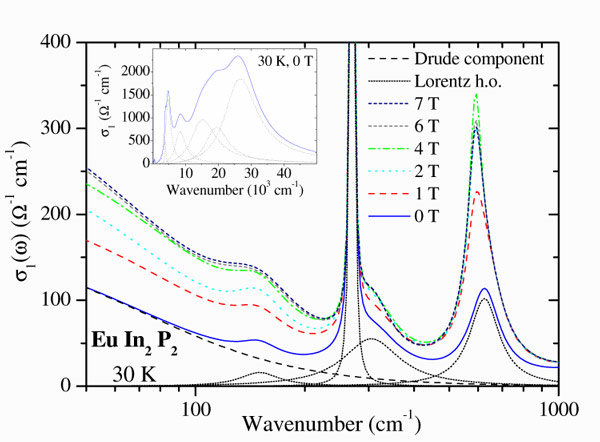Magneto-optical behaviour of EuIn2P2

EuIn2P2 belongs to the broad class of materials known as Zintl compounds. The Zintl concept for the formation of compensated-valence intermetallic compounds is based on a complete charge transfer from an alkali or alkaline-earth element to a post-transition element of the groups 13 (IIIA) or 15 (VA) in the periodic table. The concept was later extended to synthesize more complicated intermetallic compounds with new types of structures and a variety of physical properties, such as magnetic order and superconductivity. Our compound orders magnetically at TC = 24 K and exhibits concomitant large magnetoresistance effects. The main panel of Fig. 1.6 presents the field dependence of σ1(ω) at 30 K and at frequencies in the FIR range, while its inset emphasizes σ1(ω) across the entire covered spectral range. Besides the sharp IR phonon mode at 270 cm-1 and the effective metallic component emerging at ω ≤ 200 cm-1, σ1(ω) also reveals a strong absorption peaking at about 600 cm-1. This latter absorption is reminiscent to what has been seen in a large variety of so-called Kondo materials and ascribed to excitations across the hybridization gap. The most important qualitative observation is that the metallic (Drude) component as well as the feature at 600 cm-1 increase with magnetic field, i.e. they both gain spectral weight. The trend of the magnetic field dependence of σ1(ω) shown for 30 K in Fig. 1.6 is representative for all T ≤ 50 K. The enhancement of these respective mode strengths with magnetic field is only marginal in the σ1(ω) spectra evaluated at temperatures above 50 K. The observed gain of Drude weight upon increasing magnetic field suggests an enhancement of the itinerant charge-carrier concentration due to the increasing magnetization, a phenomenon that was previously observed in other compounds, like e.g. in the Eu1-xCaxB6 series, which exhibit colossal magnetoresistive effects. The similarities of the magneto-optical response in Eu1-xCaxB6 and EuIn2P2 provide strong support to recently developed theoretical concepts based on the double exchange scenario.
